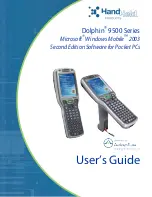
After Sales
Technical Documentation
RAE/RAK–1N
PDA Hardware
Page 6 – 42
Original, 08/96
The controller has internal 1.23V bandgap reference and soft start
circuitry for power–up. Overcurrent comparator disconnects the controller
in short circuit conditions. After this soft start cycle is made in power–up.
Output ripple voltage is determined by output capacitor ESR value which
is minimized to reduce EMI. Shutdown mode is used when battery
voltage decreases down to 5V to prevent battery from overdischarge. In
shutdown all circuits are in lowest power state.
LCDVEE regulator
LCD bias voltage is made by step–up dc–dc controller. Control scheme is
current limited pulse frequency modulation (PFM). External switch
transistor and current sense resistor are required. Maximum inductor
current goes through current sense resistor. Because required regulator
output current is small (3mA), resistor value is selected so that current
through inductor is low to reduce EMI. Also switch transistor
ON–resistance need not be lowest possible. Pulse frequency control is
made without oscillator, maximum on–time and minimum off–time are
used in pulse control. When output voltage is out of regulation the switch
turns on and it stays on until maximum on–time turns it off or inductor
current reaches its maximum value set by current sense resistor. When
the switch turns off, minimum off–time is waited.
After this the switch stays off until output voltage drops out of regulation.
This control results current pulses which are delivered on load demand
and ’skipped’ when in regulation, ’pulse skipping’ regulation. Benefits are
very low supply current at light loads because of no oscillator and high
energy conversion efficiency. Because pulses come at unspecified time
intervals switching noise is in broad frequency range. However maximum
inductor current is set to lowest practical value and output capacitor ESR
is selected for low value to reduce EMI.
Output voltage is adjusted by LCDPWM signal from PROCU. This pulse
width modulated signal is first converted to analog dc voltage by RC–filter.
This signal is fed to regulator feedback pin through a resistor which
determines the scale at which the LCD display bias voltage can be
adjusted. Temperature compensation for bias voltage is made by resistor
divider connected to regulator feedback pin. Bias voltage is controlled by
two NTC resistors so that optimum LCD contrast bias voltage is followed
accurately by the regulator in temperature range between –20
°
C and
+65
°
C. Because feedback pin comparator voltage is 1.5V and regulator
output voltage is over 20V high accuracy feedback resistors are needed
for fairly accurate output voltage.
Shutdown is controlled by PROCU. Because this is boost regulator there
is current path from input to output which must be cut separately in
shutdown. Control switch is placed between regulator output and load.
Summary of Contents for 9000i
Page 7: ...After Sales Technical Documentation RAE RAK 1N Series Original 08 96 Chapter 1 Overview ...
Page 287: ...After Sales Technical Documentation RAE RAK 1N Series Original 08 96 Chapter 9 Service Tools ...
Page 301: ...After Sales Technical Documentation RAE 1N Series Original 04 97 Chapter 10 Schematics ...
Page 303: ...RAE 1N Original 08 96 10 11 Page 1 Figure 1 Component Layout Bottom ...
Page 304: ...RAE 1N Original 08 96 10 12 Page Figure 2 Component Layout Top ...
Page 305: ...RAE 1N Original 08 96 10 13 Page Figure 3 Baseband Circuit Diagram PWRU ...
Page 306: ...RAE 1N Original 08 96 10 14 Page Figure 4 Baseband Circuit Diagram MCM1 ...
Page 307: ...RAE 1N Original 08 96 10 15 Page Figure 5 Baseband Circuit Diagram MCM2 ...
Page 308: ...RAE 1N Original 08 96 10 16 Page Figure 6 RF TX Circuit Diagram ...
Page 309: ...RAE 1N Original 08 96 10 17 Page Figure 7 RF RX Circuit Diagram ...
Page 310: ...RAK 1N 10 20 Page Amendment 1 04 97 Figure 18 PCN Component Layout Bottom ...
Page 311: ...RAK 1N 10 21 Page Amendment 1 04 97 Figure 19 PCN Component Layout Top ...
Page 312: ...RAK 1N 10 22 Page Amendment 1 04 97 Figure 20 PCN RF TX ...
Page 313: ...RAK 1N 10 23 Page Amendment 1 04 97 Figure 21 PCN RF RX ...
Page 314: ...RAK 1N 10 24 Page Amendment 1 04 97 Figure 22 UIF Schematic PCN ...
Page 315: ...RAK 1N 10 25 Page Amendment 1 04 97 Figure 23 UIF Component Layout PCN ...
Page 316: ...RAE 1N Original 05 97 10 3 Page Figure 1 PDA Block Diagram Edit 82 for layout 13a ...
Page 317: ...RAE 1N Original 05 97 10 4 Page Figure 2 PDA Power Unit PWRU Edit 108 for layout 13a ...
Page 318: ...RAE 1N Original 05 97 10 5 Page Figure 3 PDA Serial Interface SIRU Edit 24 for layout 13a ...
Page 319: ...RAE 1N Original 05 97 10 6 Page Figure 4 PDA MCU and Memory PROCU Edit 121 for layout 13a ...
Page 320: ...RAE 1N Original 05 97 10 7 Page Figure 5 PDA EMIU Edit 21 for layout 13a ...
Page 321: ...RAE 1N Original 05 97 10 8 Page Figure 6 Keyboard matrix Edit 24 for layout 13a ...
Page 322: ...RAE 1N Original 05 97 10 9 Page Figure 7 PDA Memory Edit 28 for layout 13a ...
Page 323: ...RAE 1N Original 05 97 10 10 Page Figure 8 PDA Component Layout 13a ...
Page 324: ...RAE 1N Original 08 96 10 18 Page Figure 1 UIF Schematic ...
Page 325: ...RAE 1N Original 08 96 10 19 Page Figure 2 Component Layout Uif ...
Page 326: ...After Sales Technical Documentation RAE RAK 1N Series Original 08 96 Accessories ...
Page 352: ...After Sales Technical Documentation Appendix 2 RAE RAK 1N Amendment 1 04 97 PARTS LISTS ...
Page 402: ...After Sales Technical Documentation Appendix 1 RAE RAK 1N Original 08 96 QUICK GUIDE ...
Page 434: ......








































